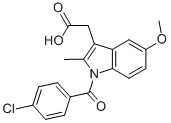
Product name:Indometacin
CAS:53-86-1
Molecular Formula:C19H16ClNO4
Formula Weight:357.79
Specification:5g
Description:Indometacin is a white or yellowish crystalline powder. Melting point of 158-162 ℃. Soluble in acetone, slightly soluble in ethanol, chloroform, ether, almost insoluble in water. Tasteless, almost odorless.
Indometacin is a kind of effect is stronger than corticoid anti-inflammatory and antipyretic and analgesic, by inhibiting cyclooxygenase reduce the synthesis of prostaglandin (PG), to prevent the formation of the nere impulses, inflammation tissue inhibiting inflammatory reaction, including inhibition of leukocyte chemotaxis and lysosomal enzyme release, etc., to produce antipyretic, analgesic and anti-inflammatory effects. Indometacin has a strong anti-inflammatory and antipyretic effect. Its anti-inflammatory effect is 84 times stronger than that of butaxone and stronger than hydrocortisone. Combined with glucocorticoids, aspirin and butaxone, it can reduce their dosage, toxicity and side effects and improve the efficacy. The antipyretic effect was 10 times that of aminobilin. The analgesic effect was weak, and it only had obvious analgesic effect on inflammatory pain, but the analgesic effect on inflammatory pain was better than that on baotaisong, annaijin and salicylic acid. Clinical use is mainly used for acute, chronic rheumatic or rheumatoid arthritis, ankylosing spondylitis, bursitis, tenosynovitis, joint bursitis, osteoarthritis, acute gout and cancer pain, which are not easily tolerated to salicylic acid drugs, or whose effect is not obvious. In recent years, researchers have tried to use Indometacin for biliary colic, dysmenorrhea, migraine, glomerulonephritis, polyuria, salmonella gastroenteritis, postural hypotension, and barthes syndrome, all of which have good efficacy. Indometacin is also used to treat eye pigment meningitis, keratitis, sclerotitis, glaucoma, and fever caused by cancer or other uncontrollable fever. The dermatology department is used for lupus erythematosus, bactria syndrome, scleroderma, nodular erythema, herpes zoster, and joint psoriasis. External use for eczema, allergic dermatitis, photosensitive dermatitis, local pain.

